论文网址:Graph Neural Networks in Network Neuroscience | IEEE Journals & Magazine | IEEE Xplore
英文是纯手打的!论文原文的summarizing and paraphrasing。可能会出现难以避免的拼写错误和语法错误,若有发现欢迎评论指正!文章偏向于笔记,谨慎食用
1. 省流版
1.1. 心得
(1)一看时间2022,哥们儿你真是错过了2022的GNN盛世
(2)妈妈,感觉看综述被生僻英文单词输出了
(3)这Intro是真长啊一口气读下去差点没噎死我
(4)第二次challenge2.3.2. 脑图一般是无向图,能不能发展一点有向啊,虽然是作为外行人的发言
(5)挑战与见解写得有点紧密联系了最好还是分开吧而且那个见解有点vague
1.2. 论文总结图
2. 论文逐段精读
2.1. Abstract
①Medical neuroimaging now can present the morphology, structure, and function of brain
②Their citations list: GitHub - basiralab/GNNs-in-Network-Neuroscience: A review of papers proposing novel GNN methods with application to brain connectivity published in 2017-2020.
morphological n.同 morphologic adj.形态学(上)的;【语】词法的
2.2. Introduction
①The three representations of brains bring time, resolution and domain information of brain:
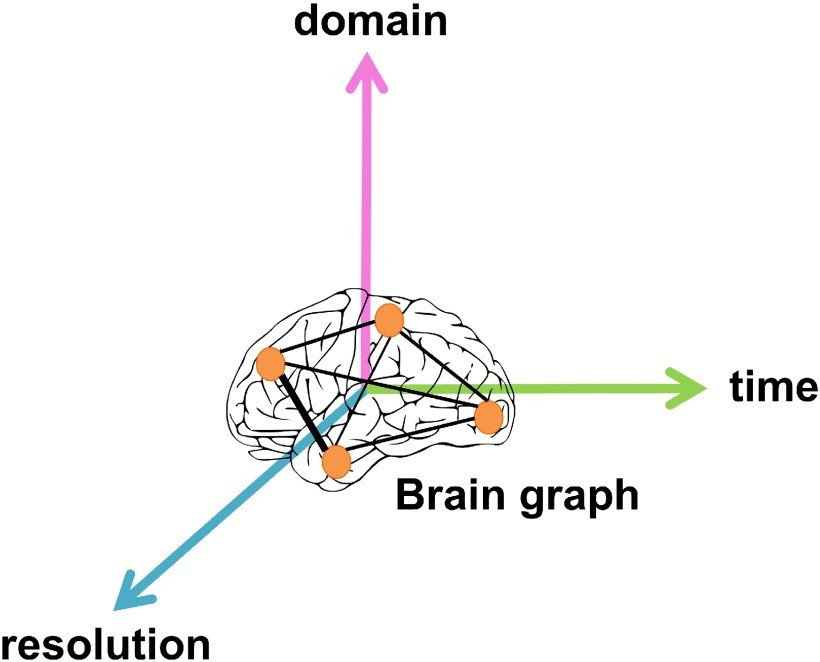
②Multi-modality data will bring different information of brain. Human Connectome Project (HCP), the Baby Connectome Project (BCP) and the Connectome Related to Human Disease (CRHD) datasets focus to collect such data.
③Functional connectivity (FC) matrix can be generated by CONN toolbox or groupwise whole-brain parcellation methods and structural and morphological connectivity (SC/MC) matrices can be measured by FSL toolbox and Desikan-Killiany atlas via FreeSurfer software(应该只列了一部分啦)
④There are methods that can predict images with other modalities by a single imaging modality
⑤Moreover, mapping brain graph from non Euclidean domains to other domains such as geometric and hyperbolic domains
⑥Citing other surveys and list the differences
underpinning v.基础;加强;巩固;构成(…的基础等) underpin的现在分词 n.(学说、理论等的)基础;基础结构;基础材料;(人的)腿
endogenous adj.内源性的;内生的
holistic adj.整体的;全面的;功能整体性的
coalescent adj.合并的;接合的 n.联合;合并
internodal adj.节间的
nascent adj.新生的;萌芽的;未成熟的
taxonomy n.分类法;分类学;分类系统
2.3. What Do Graph Neural Networks Offer to Network Neuroscience?
2.3.1. GNN Overview
①GNNs can be categorized into three main types: Graph Convolutional Network (GCN), Graph Attention Network (GAT) and message-passing mechanism(为什么消息传递机制不被包含在GCN里啊?)
②GNN usually defines graph as , where
denotes the pairwise correlation,
denotes feature matrix,
denotes the nodes set and
denotes the edges set.
③If there is no feature of node, setting
④The aggregation method of GCN:
where denotes the activate function,
denotes the filter that presents the graph convolutional weights,
dentoes the GCN function,
and
⑤Graph-based model and population based model:
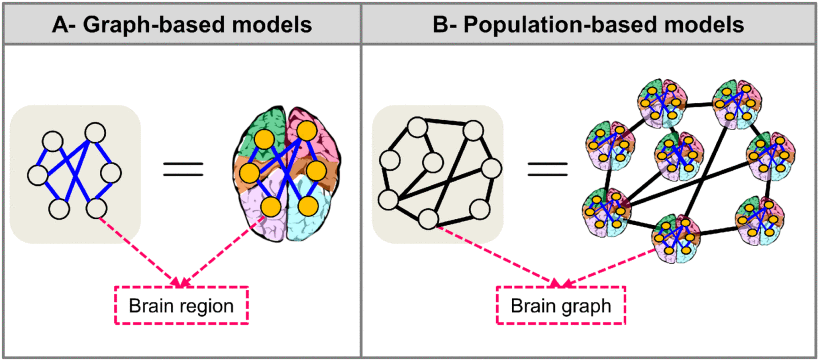
2.3.2. Brain Graph Overview
①Basically, regarding neurons as nodes and corresponding synapses as edges is a method of constructing brain graph. However, it is relevant expensive in computing(嘻嘻,文心了一下大脑中大概有120亿到140亿个神经元,往死里算!所以后来的ROI划分(一组神经元!)也算是迈出了很大一步呢!)
②Traditionally, brain graphs are undirected graphs.
③Common method of brain graph construction:
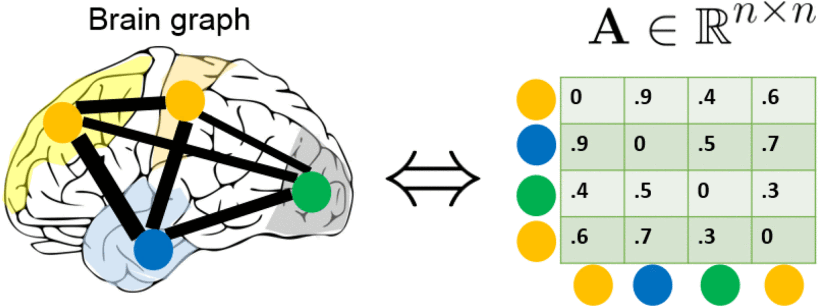
(1)Morphological brain graphs
①Method: cortical measures of detecting the sulcal depth and cortical thickness
②Extraction: from T1-weighted images
③Main preprocessing: "skull stripping, motion correction, T1-w intensity normalization, topology correction, segmentation of the sub-cortical white matter and deep grey matter volumetric structures and cortical hemisphere construction"
④Dividing regions by specific atlas, such as Desikan-Killiany Atlas. The weighted edges of ROIs are absolute difference
(2)Functional brain graphs
①Method: constructed by fMRI, namely blood-oxygen-level-dependent (BOLD) signal
②Edges: correlations between ROI
③Node: with no feature
(3)Structural brain graphs
①Method: constructed by diffusion tensor imaging (DTI) or diffusion spectrum imaging (DSI), which measured by diffusion of water molecules. It can distinguish gray matter and white matter
②Edges: absolute difference of number of fibers in different ROIs
2.3.3.Literature Search and Taxonomy Definition
①Data focused: 2017.1.1 - 2020.12.31
②Databases: IEEExplore, PubMed, Research Gate, Arxiv Sanity and Google Scholar using
③Keywords: “brain graph”, “brain network”, “connectome”, “GNN”, “graph representation learning”, “network neuroscience”, “graph neural networks”
④Journals/Conferences: Medical Image Computing and Computer Assisted Intervention conference (MICCAI), the Information Processing in Medical Imaging (IPMI) conference, Journal of Neuroscience Methods, IEEE Transactions on Medical Imaging journal, Frontiers in Neuroscience, Neuroimage, Cerebral Cortex journals and bioRxiv
⑤Ignore: CNN/ML in brain
⑥Three domains in brain graph: prediction, integration and classification

⑦Specific types in brain domain:
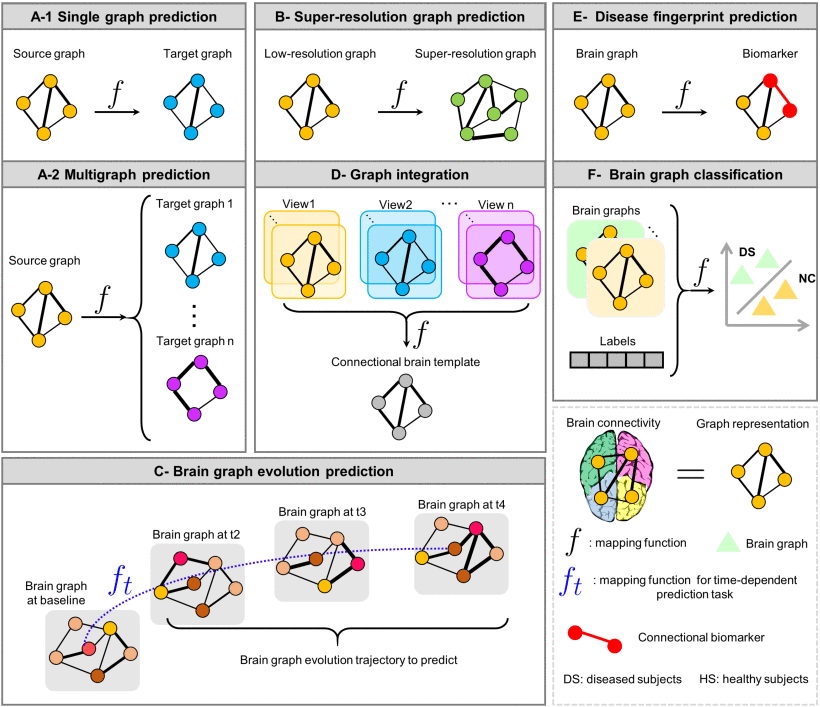
primer n.底漆;初级读本;底层涂料;入门书;启蒙读本;识字课本
2.3.4. Brain Graph Prediction
①⭐Patients may lack multi-times scans over time or multi-modality scan images
②The data of brain image is too little
③Brain Graph Prediction Publications
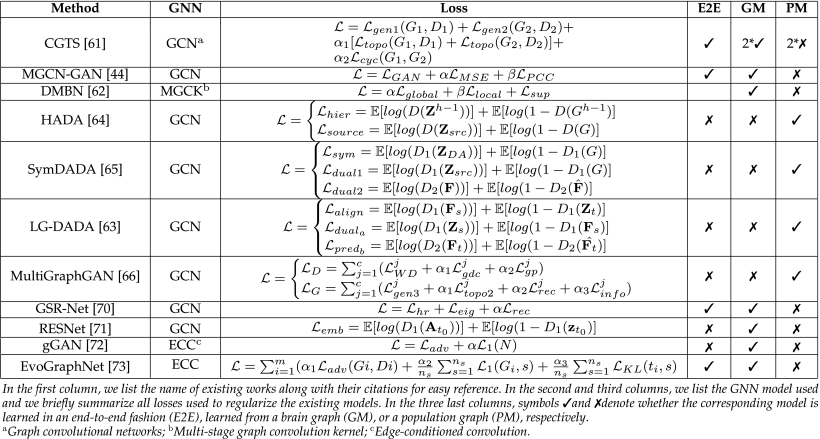
④Brain Graph Integration Publications
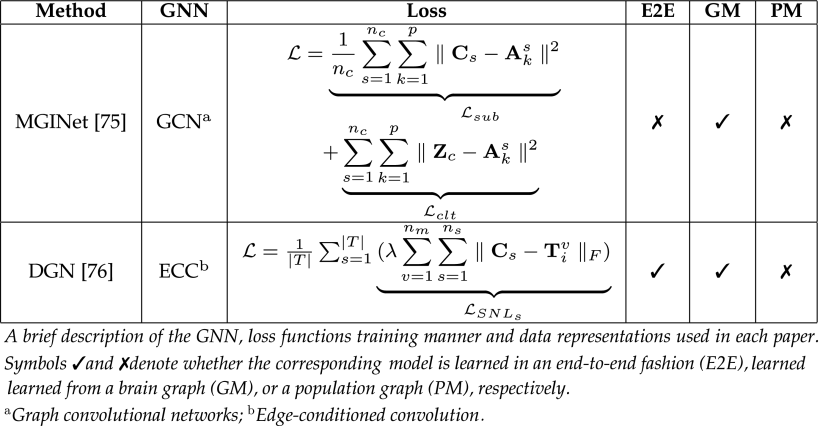
⑤Disease Classification Publications

⑥Biomarker Identification Publications

⑦Summary of lost functions:
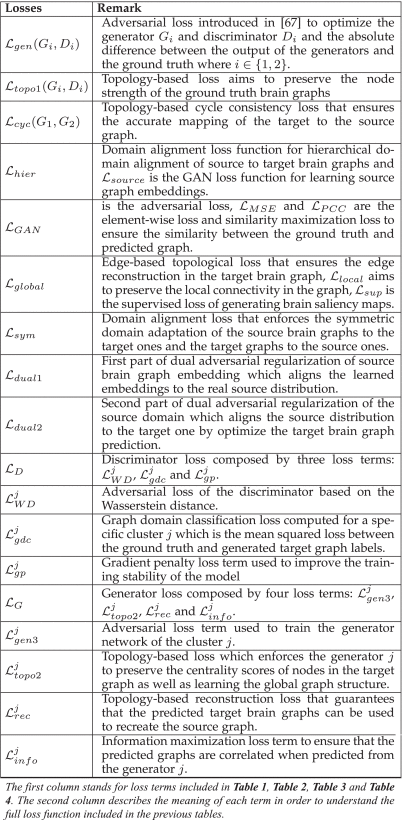
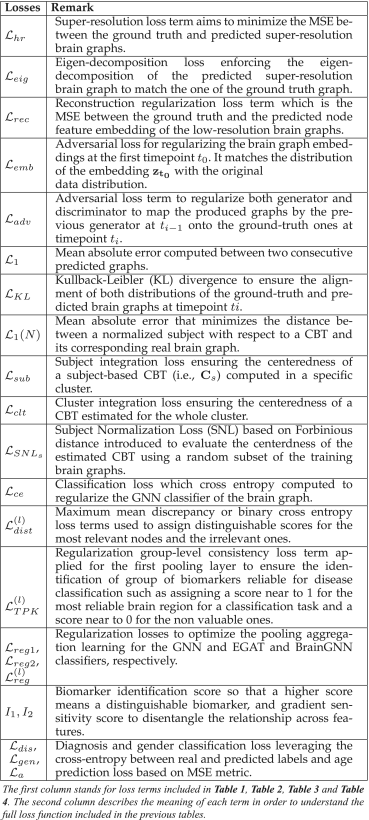
(1)Cross-Domain Graph Prediction
①Problem statement: for original graph , learning a manpping function
. After that,
②Categories: single/multi graph prediction
③Single graph prediction: such as GAN based models, they predict brain graph with another modality from one source modality. It requires different training when predict different modalities of brain graph
④Multi graph prediction: such as GCN based autoencoder methods
⑤Challenges: a) not all of them are end-to-end, which may accumulates errors, b) GAN based models are possible face mode collapse, c) few topological structured considered
(2)Cross-Resolution Graph Prediction
①Problem statement: for low-resolution brain graph , learning a mapping function
to map
②Example: U-autoencoder constructed by GCN layers, which inspired by U-Net
③Future challenges: better GNN framework, computing efficiency, higher accuracy. What is more, people can fucos on multi-resolution graph synthesis in the future
(3)Cross-Time Graph Prediction
2.3.5. Brain Graph Integration
2.3.6. Brain Graph Classification
(1)Brain State Classification
(2)Biomarker Identification
2.4. Discussion and Outlook
2.4.1. Toward Clinical Translation
2.4.2. Outlook
3. 知识补充
3.1. Structural and anatomical images
大脑的解剖像和结构像在描述大脑时各有侧重,两者之间存在一些差异。
解剖像:主要关注大脑的形态和外观。它显示大脑的各个部分,如左脑、右脑、大脑皮质、大脑髓质等,并详细描述这些部分的形状、位置和相互关系。解剖像通常通过医学成像技术(如CT扫描、MRI等)获得,可以显示大脑的宏观结构。
结构像:则更侧重于大脑的内部结构和组织。它关注大脑的微观层面,包括神经元的排列、突触的连接、神经纤维的走向等。结构像通过更精细的成像技术(如电子显微镜、高分辨率MRI等)获得,能够揭示大脑的复杂结构和功能。
简而言之,解剖像提供了大脑的整体外观和宏观结构,而结构像则提供了大脑的微观结构和组织细节。两者结合使用可以更全面地了解大脑的形态和功能。
3.2. Brain images
(1)Functional images: always named "FunRaw", obtained by fMRI
(2)Anatomical images: always named "T1Raw", obtained by sMRI
(3)Structural images: always named "T2Raw", obtained by sMRI
(4)但是作者在文章中说morphological images是T1像,而structural images来自DTI。暂时持保留意见
4. Reference List
Bessadok, A., Mahjoub, M. & Rekik, I. (2022) 'Graph Neural Networks in Network Neuroscience', IEEE Transactions on Pattern Analysis and Machine Intelligence, 45 (5), pp. 5833-5848. doi: 10.1109/TPAMI.2022.3209686



(32))

)
)

office最最最基础背诵一)




使用)



)

